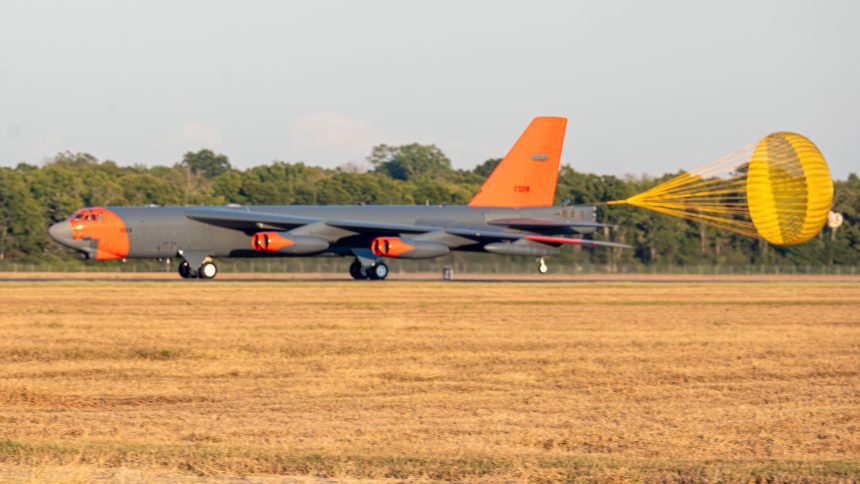The B-52 sporting the amazing throwback paint scheme has returned at Barksdale Air Force Base.
As reported in details a few days ago, a U.S. Air Force B-52H Stratofortress bomber was photographed by our friend Rob Stephens at Redhome Aviation, taking off from Tinker Air Force Base, Oklahoma, home of the Oklahoma City Air Logistics Complex, on Sept. 30, 2024 sporting an eye catching paint scheme.
The B-52H 61-0028 “Wolfpack” had forward fuselage, wings near the wingtips, engine nacelles, and vertical stabilizer painted in dayglo orange, contrasting the typical overall dark gray paint of the Stratofortress aircraft. As explained, the bomber was not given any markings, as the “OT” and “49 TES” tail markings, black arrow point on the tail, and “U.S. Air Force” on the fuselage will be applied upon return to Barksdale AFB, Louisiana.
The U.S. Air Force has now released some official images of the test aircraft.
These photographs depict the “throwback B-52” arriving at Barksdale. According to the captions, “the test orange scheme was used to remind everyone of the B-52’s incredible journey and continuous progress made in the U.S. Air Force.”
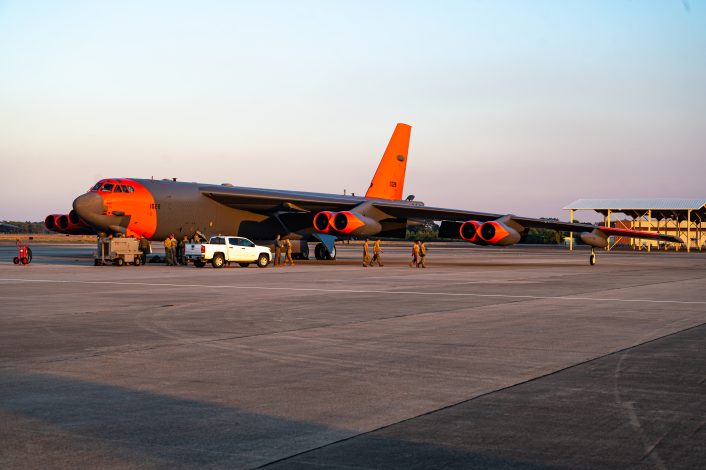
The B-52 with orange accents that touched down at Barksdale is part of the 49th Test and Evaluation Squadron, which leads operational testing for the bombers.
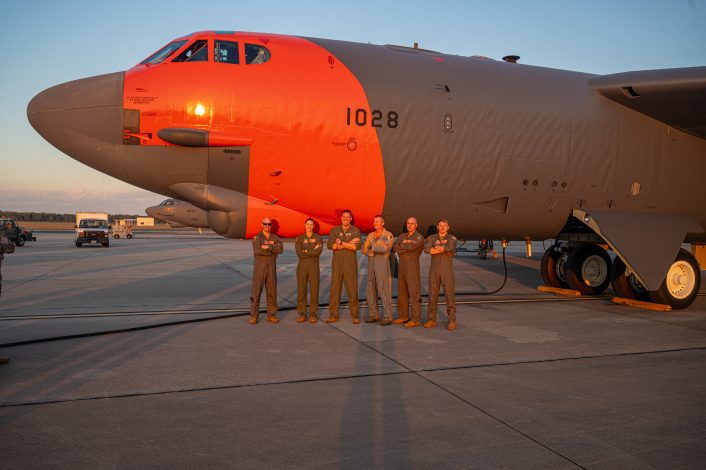
Under testing after six decades of operations
In the next few years, the Air Force plans to modernize its fleet of B-52H bombers with a series of upgrades that will extend the bomber’s service life into the 2050s, by which time the aircraft will be nearing 100 years in operation.
The “new” B-52s will be designated B-52J.
Rolls-Royce F130 engines will replace the aging Pratt & Whitney TF33-PW-103 engines through its remaining operational life, significantly improving fuel efficiency, range, and reducing maintenance costs. Another key upgrade is the installation of a modified version of the APG-79 AESA radar, used in the F/A-18EF Super Hornet. This radar will enhance the B-52’s range and situational awareness while freeing up space for additional electronic warfare capabilities. Externally, the removal of the AN/ASQ-151 Electro-Optical Viewing System (EVS) will streamline the bomber’s appearance, as modern targeting pods have made the EVS obsolete.
Inside, the B-52 cockpit will receive new digital multifunction displays, a hybrid mechanical-to-digital throttle system, new data concentrators, and an upgraded engine management system. While not a fully modern glass cockpit, these upgrades will improve functionality. Additionally, crew size will be reduced from five to four members.
The B-52J will also feature humps near the wing roots, possibly for classified equipment such as satellite communications systems, further enhancing the bomber’s capabilities.
The Air Force aims to complete integration and deliver the first modified B-52s by 2026-2027, with full operational capability anticipated by 2030.
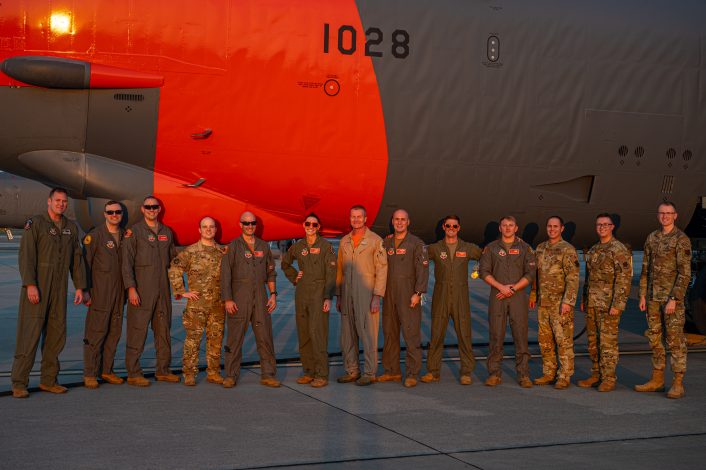
The previous orange BUFFs
In mid-1957, NASA made the decision to replace the B-36 Peacemaker with the B-52 Stratofortress as the launch aircraft for the X-15 hypersonic research program. The B-36 was nearing the end of its operational life, and it was anticipated that finding spare parts to maintain it after retirement would be challenging.
As the X-15 project advanced, two B-52 Stratofortresses, the NB-52A and NB-52B, were chosen to serve as the launch platforms. The NB-52B, designated 52-0008 and nicknamed “The Challenger,” continued in this role until its last mission in November 2004, while the NB-52A, known as “The High and Mighty One” with tail number 52-0003, was retired earlier in 1969. “The High and Mighty One” is still preserved and displayed at the Pima Air & Space Museum in Arizona, with its distinctive orange markings.
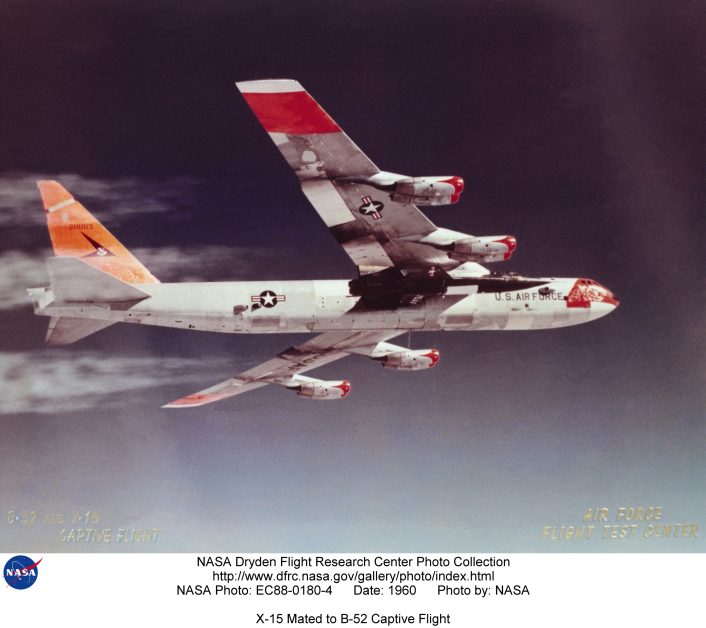
The NB-52B served as an airborne launch platform, essentially acting as a flying launch pad. It operated at altitudes of nine miles, providing the rocket planes it carried with necessary fuels, gases, and electrical power. To handle this role, the right wing of the aircraft was reinforced and equipped with a pylon capable of carrying over 50,000 pounds—approximately a fifth of the aircraft’s total weight. This made the Stratofortress a crucial asset in various aeronautical research endeavors, including those that eventually contributed to the development of the Space Shuttle.
One of the NB-52B’s key contributions was helping validate the Space Shuttle’s steep gliding landings. It accomplished this by launching wingless lifting bodies, which demonstrated that such landings were possible. The aircraft also played a vital role in testing parachutes for recovering the Shuttle’s solid rocket boosters and the drag chute used during Shuttle landings. Despite its increasing age and the growing cost of maintenance, the NB-52B continued to support a wide array of cutting-edge research throughout the 1970s and 1980s, launching drones, remotely piloted vehicles, and experimental payloads.
In addition to its launch duties, the NB-52B was used in research on wake turbulence, served as a target for gunnery exercises, and tested fuel additives aimed at reducing pollution. At one point, it flew with ten engines when additional engines were mounted under the bomb bay for testing purposes. During the X-38 program, the aircraft deployed the largest parafoil in history, with a surface area larger than a Boeing 747’s wing.
The NB-52B’s last mission took place in 2004, when it launched the X-43A, which reached a speed of Mach 9.6 using the most powerful air-breathing engine ever built. After a long and significant career contributing to both aviation and space research, the NB-52B was officially retired on December 17, 2004, during a ceremony at NASA’s Dryden Flight Research Center.
At the time of its retirement, “Balls 8” (a nickname derived from its NASA tail number 52-008, where military slang refers to leading zeroes as “Balls”) was the oldest B-52 still in active service and the only one that wasn’t an H model. It also had the lowest total flight hours of any operational B-52. The aircraft is now displayed permanently near the north gate of Edwards Air Force Base in California.

